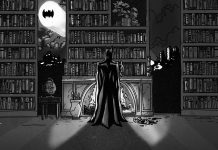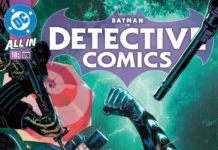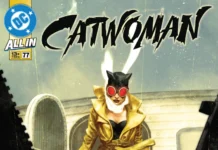PREVIOUS: “A Joker’s Dozen, Part 4“
One of the touchstones of The Joker’s interpretation in comics is the first dozen stories featuring the Joker that follow his introduction as a cold blooded killer and his transformation into a clever prankster that would bedevil Batman over the years without falling prey to the morality police. There are a dozen stories that make up this initial introduction, so 7 parts to go after this.
 The Return: No explanation, apparently he regained consciousness and just left a burning building. No explanation really necessary.
The Return: No explanation, apparently he regained consciousness and just left a burning building. No explanation really necessary.
The Plot: The Joker is running a crime ring in disguise out of a music store, and robbing the robbers as The Joker so he doesn’t have to split the loot.
Body Count: One – The District Attorney killed by The Joker using a record that releases poison gas.
Other Mayhem: Museum caretaker knocked out by robbers, Batman and robbers brawl in museum, gang of robbers subdue band of musicians and impersonate band in order to rob party, party goers threatened by robbers, robbers threatened by Joker, Batman and robbers brawl while Joker makes his getaway giving Batman a rap on the head during a scuffle, Joker traps Batman in shatterproof glass cylinder with limited air, and. Joker gasses guards of a Jade Buddha and scuffles with Batman and Robin.
Best Kill: Death by record!
The Outthink: Batman uses acid from his utility belt to escape from Joker’s deathtrap.
The Comeuppance: The Joker is knocked over the railing of a ship at sea, miles from shore.
To me, this story is the first steps in the Joker’s transition from one dimensional plotter of death to a more rounded and versatile villain. Unfortunately, this story is rather routine, starting with the rather generic title where a superior title “Symphony of Murder” is alluded to in the splash page, and as a whole it lacks the panache and cleverness that the Joker will evolve into.
While continuing the “Joker doesn’t work well with normal crooks” theme for the character, there’s nothing really special about the crime spree that the Joker plans. There’s nothing really unique to the Joker being a master of disguise robbing his own men idea, although the idea of the Joker having many skills including disguise is always welcome. The most memorable part of the story is easily the murder of the District Attorney though. So memorable that Steve Englehart would borrow it for his DARK DETECTIVE mini-series, just updating it for the CD age. The use of gasses instead of merely injectable venom adds another weapon to the Joker’s arsenal as well. And it continues the theme that the Joker had a criminal past and was killing off city officials as a method of revenge and anarchy.
The mystery identity of the Joker is boldly hinted at in the music shopkeeper’s name, A. Rekoj. The backward spelling is typical as the Joker will never be one that wants to remain totally anonymous. Just anonymous enough to avoid obvious suspicion. Joker will use the backwards spelling several times and Batman will play that same game at least once.

Of added interest, there’s a lot of emphasis on circles in the art. The record of death and the always plentiful shots of full moons are significant visual cues. But practically every page of the story sports a circular panel breaking up the straight grid. And it works well in many cases throughout the story. It’s easy to credit this to Jerry Robinson, and I’ll do so because I think it’s correct. The art in the feature had improved by leaps and bounds since “The Case of the Chemical Syndicate”, less than two years previous, and even since the first Joker story. You just have to compare two cases of glass jar traps to see how obvious the improvement is.
All in all, a workmanlike tale that at least is a step away from the poisoning/gem stealing plot of the Joker’s earliest days. The next two stories will follow in the same pattern in trying to integrate the out-sized character of the Joker with relatively straightforward crime, which turns out to be a somewhat awkward fit. – Robert Reineke










